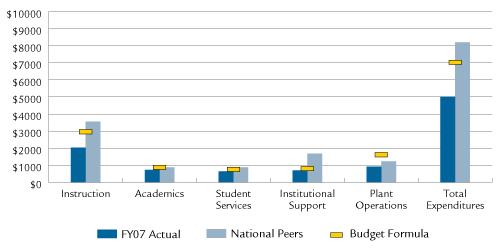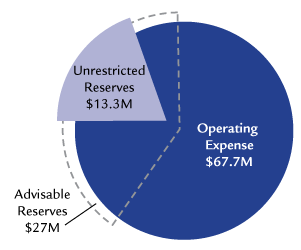Framingham State College
Framingham State College (FSC) was founded by Horace Mann in 1839 as the first state-supported school in the United States for the education of teachers. The College integrates liberal arts and science programs with a variety of professional programs at the baccalaureate and master's levels. Framingham is committed to offering programs infusing technology throughout the curriculum.
Program of Distinction
Collaborations
Access Indicators
Affordability Indicators
Student Success and Academic Quality Indicators
Fiscal Effectiveness and Efficiency Indicators
Program of Distinction
In September 2007, Framingham State College (FSC) and the United Way of Tri-County (UWTC) announced a partnership designed to promote service learning and community engagement at the College. The partnership has resulted in a number of service collaborations involving the UWTC client agencies and has especially enhanced the College's first-year experience. To date, over 400 first-year students have participated in community-based initiatives. The annual "Day for Kids," held in downtown Framingham each September, brings FSC students, faculty and staff into direct contact with some of the host community's most deserving young people, creating a fun and safe environment that helps to lower cultural, psychological, and social barriers to college attainment. The UWTC's volunteer opportunity database allows students, faculty and staff to find worthy service projects in Framingham and surrounding towns. The partnership was instrumental in the College's successful application for a VISTA assignment, allowing the establishment and staffing of an Office of Community Engagement, which will be jointly supported in the future by both the College and the United Way.
Collaborations
- In 2008, FSC and Framingham High School became one of five early outreach partnerships between colleges and public schools, an effort supported through a grant from the Jack Kent Cooke Foundation to Tufts University and the Massachusetts Campus Compact. The program is primarily designed to serve academically disadvantaged youth. A full-time advisor from the College Advising Corps works with guidance counselors from the high school and admissions representatives from the College to help illuminate the path to post-secondary attainment. Currently, the program serves 51 Framingham High School Students, all of whom participate in post-secondary planning activities. The students take college essay workshops, develop academic skills, attend a "college day" designed especially for them, and learn about financial aid from MEFA representatives. While the College's relationship with Framingham High School has always been strong, this partnership expands on this relationship and provides focused attention for some of the high school's most deserving students.
- FSC's "College Tomorrow" initiative is a free college-readiness summer program that serves rising juniors and seniors from high schools in the surrounding region. Students are chosen for the program based on their ability to benefit from an intensive pre-college experience that challenges them to rise to college-level expectations both inside and outside of the classroom. As participants in the program, run through the College's Center for Academic Support and Advising, students "enroll" in writing, math and public speaking courses taught by members of the College's faculty in order to sharpen academic skills. Participants also learn how to conduct a college search process that is matched with their interests and aspirations, and to understand and develop college-funding options. Now in its sixth year, the program has served over 120 high school students from a number of school districts in the MetroWest area of the state.
- FSC has developed a common articulation agreement for its Bachelor's Degree in Liberal Studies for graduates of Middlesex Community College, Mount Wachusett Community College and Northern Essex Community College. This program allows students who have earned an Associate's degree from one of these three community colleges to complete bachelor's degree requirements in the Liberal Studies program entirely on-line, allowing maximum flexibility for students who are returning to college and are balancing work and family obligations while pursuing a four-year degree. The program is offered through the College's Division of Graduate and Continuing Education.
- FSC's Department of Consumer Sciences is the recipient of a grant from the MetroWest Community Health Care Foundation to provide training and technical assistance to the 24 client-grantees of the Foundation's Childhood Obesity Initiative. Now in its third year, the grant provides $100,000 per year to the College to assist with many different programs, including after-school initiatives in public schools and YMCAs throughout MetroWest. The department's nutrition staff and faculty work with each program to support its specific needs, ranging from nutrition curriculum development to messaging that targets students and families. Additionally, the project allows students in FSC's Didactic Program in Dietetics to develop program and education skills by teaching in Framingham Schools. These students also prepare "MetroWest Healthy Family Table," a monthly column for the MetroWest Daily News. College faculty and staff also write and distribute The MetroWest Wellness Way, a quarterly newsletter for families.
Section I: Access to Public Higher Education in Massachusetts
Access Indicators
Fall 2007 Enrollment
| Undergraduate Headcount |
3,828 |
| Undergraduate FTE |
3,432 |
| Graduate Headcount |
2,075 |
| Graduate FTE |
757 |
Fall Enrollment
Over the last three years, fall headcount enrollment has remained relatively stable.
Over the last three years, fall full-time equivalent (FTE) enrollment has remained relatively stable.
Annual 2007–2008 Enrollment
| Undergraduate Headcount |
4,906 |
| Undergraduate FTE |
3,630 |
| Graduate Headcount |
5,600 |
| Graduate FTE |
1,433 |
Annual Enrollment
Over the last three years, annual headcount enrollment has remained relatively stable.
Over the last three years, annual FTE enrollment has remained relatively stable.
Looking Back: Undergraduate and Graduate Fall Headcount Enrollment

Fall 2007 Minority Enrollment
12.5%
Minority Enrollment
Lower than the Greater Boston Region's minority representation of 17.9%.
Fall 2007 Community College Transfer Students
196
Community College Transfer Students
Over the last three years, the number of community college transfer students has increased 45.2%.
Section II: Affordability of Massachusetts Community Colleges
Affordability Indicator
2007–2008 Tuition and Fees as a Percent of Median Family Income
7.4%
% of Median Family Income
Below the Northeast regional average of 9.1%.
Looking Back: Tuition and Fees as a Percent of Median Family Income
|
FY2004 |
FY2005 |
FY2006 |
FY2007 |
FY2008 |
| Framingham State College Tuition and Fees |
$4,324 |
$4,654 |
$4,999 |
$5,450 |
$5,798 |
| State Median Family Income |
$67,527 |
$68,701 |
$71,655 |
$74,463 |
$78,497 |
| "X" as a Percent of State Median Family Income |
| X = Framingham State College Tuition and Fees |
6.4% |
6.8% |
7.0% |
7.3% |
7.4% |
| X = Massachusetts State Colleges' Average Tuition and Fees |
6.7% |
7.3% |
7.5% |
7.8% |
7.7% |
| X = Northeast Average Tuition and Fees |
|
9.2% |
9.3% |
9.3% |
9.1% |
Section III: Student Success and Academic Quality
Success and Quality Indicators
Fall 2006 Cohort First-Year Retention Rate
73.2%
Fall Cohort First-Year Persistence
Comparable to the segmental rate of 74.4%, the national rate of 73.6%, and the institutional peer retention rate of 68.1%.
Looking Back: Fall-to-Fall Retention Rate
|
Cohort |
|
Entering 2002 |
Entering 2003 |
Entering 2004 |
Entering 2005 |
Entering 2006 |
| Framingham State College Rate |
72.4% |
71.8% |
75.1% |
72.0% |
73.2% |
| Peer Rate |
|
73.3% |
74.5% |
73.8% |
72.9% |
| Massachusetts State Colleges Segment Rate |
74.6% |
75.2% |
76.2% |
73.5% |
74.4% |
| National Average |
|
74.3% |
74.0% |
73.7% |
73.6% |
1999–2001 Cohort Six-Year Graduation Rate (3-Year Average)
45%
Six-Year Graduation Rate
Below the segmental rate of 47.3% but above the institutional peer rate of 36.5%.
Looking Back: Six-Year Graduation Rate
|
Cohort |
|
|
Entering 1998
Grad. by 2004 |
Entering 1999
Grad. by 2005 |
Entering 2000
Grad. by 2006 |
Entering 2001
Grad. by 2007 |
Rolling Average Entering 1999– 2001 |
| Framingham State College Rate |
44.4% |
42.0% |
50.2% |
42.8% |
45.0% |
| Peer Rate |
34.5% |
35.5% |
37.2% |
36.8% |
36.5% |
| Massachusetts State Colleges Segment Rate |
47.6% |
47.2% |
48.9% |
45.9% |
47.3% |
Total Degrees Conferred in FY2008
1,156
Degrees Conferred
Average degrees conferred per year over the last three years: 1,199
Looking Back: Degrees Conferred

2007 Pass Rate on the Massachusetts Test for Educator Licensure
99%
Number of Students Passing MTEL
159
Massachusetts Test for Educator Licensure Pass Rate
Above the Board of Higher Education's target pass rate of 80%.
Percent of New Students Who Were Special Admits in Fall 2007
5.7%
Special Admissions Students
Meets the Board of Higher Education requirement of enrolling less than 10% special admissions students per year. (See Appendix.)
Section IV: Effective and Efficient Use of Resources
Effectiveness and Efficiency Indicators
Effective Projects and Initiatives
- In response to the DCAM/BHE-sponsored Space Utilization Study completed as part of the comprehensive Framingham State College Capital Master Plan, the Framingham State College Budget and Resource Committee's Effectiveness and Efficiency Sub-Committee developed recommendations for College governance consideration. Over the past year, a number of these recommendations have been implemented including creation of additional course scheduling blocks based on utilization study findings.
- In response to the recommendations of the College's Climate Action Plan, plans have been developed for conversion of the campus power plant that would result in a reduction of over 2,000 metric tons of CO2 per year, a 30% reduction in emissions; funding is being sought for this project through the potential federal stimulus process.
Resource Allocation
Expenditures per Student—Actual, National Peers, and Budget Formula

Note: This graphic was revised on May 6, 2009. The previously posted graphic displayed the data inaccurately.
FY2008 Primary Reserve Ratio
| Unrestricted Reserves (UR) |
$13,337,000 |
| Total Operating Expenses (TOE) |
$67,672,000 |
| Primary Reserve Ratio (UR/TOE) |
19.7% |
Primary Reserve Ratio

Compliance
No materials weaknesses based on annual external independent audit:

